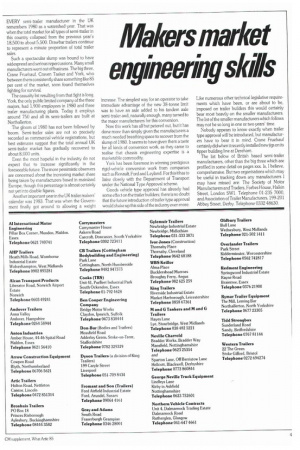Makers market engtheering
Page 133

If you've noticed an error in this article please click here to report it so we can fix it.
EVERY semi-trailer manufacturer in the UK remembers 1980 as a watershed year. That was when the total market for all types of semi-trailer in this country collapsed from the previous year's 18,500 to about 5,500. Drawbar trailers continue to represent a minute proportion of total trailer sales.
Such a spectacular slump was bound to have widespread and serious repercussions. Many small manufacturers went out of business. The big three. Crane Fruehauf. Craven Tasker and York, who between them consistently share something like 85 per cent of the market, soon found themselves fighting for survival.
The casualty list resulting from that fight is long. York, the only public limited company of the three majors, had 1,900 employees in 1980 and three trailer manufacturing plants. Today it employs around 750 and all its semi-trailers are built at Northallerton.
The gloom of 1980 has not been followed by boom. Semi-trailer sales are not so precisely recorded as commercial vehicle registrations, but best estimates suggest that the total annual UK semi-trailer market has gradually recovered to about 8,000 units.
Even the most hopeful in the industry do not expect that to increase significantly in the foreseeable future. The more pessimistic observers are concerned about the increasing market share being taken by manufacturers based in mainland Europe, though this percentage is almost certainly not yet into double figures.
Another important year in the UK trailer makers' calendar was 1983. That was when the Government finally got around to allowing a weight increase. The simplest way for an operator to take immediate advantage of the new 38-tonne limit was to have an axle added to his tandem axle semi-trailer and, naturally enough, many turned to the major manufacturers for this conversion.
Now this work has all but petered out, but it has done more than simply given the manufacturers a much needed breathing space to recover from the slump of 1980. It seems to have given them a taste for all kinds of conversion work, as they came to realise that chassis engineering expertise is a marketable commodity.
York has been foremost in winning prestigious rigid-vehicle conversion work from companies such as Renault, Ford and Leyland. For this it has to liaise closely with the Department of Transport under the National Type Approval scheme.
Goods vehicle type approval has already had some effect on the trailer builders; there is no doubt that the future introduction of trailer type approval would shake up this side of the industry even more. Like numerous other technical legislative requirements which have been, or are about to be, imposed on trailer builders this would certainly bear most heavily on the smaller manufacturers. The list of the smaller manufacturers which follows may not be so long in one or two years' time.
Nobody appears to know exactly when trailer type approval will be introduced, but manufacturers have to bear it in mind. Crane Fruehauf certainly did when it recently installed new jigs on its tipper building line at Dereham.
The list below of British based semi-trailer manufacturers, other than the big three which are profiled in some detail on pages xxx. Is, I believe. comprehensive. But two organisations which may be useful in tracking down any manufacturers I may have missed are: The Society of Motor Manufacturers and Traders. Forbes House, Halkin Street. London SW1. Telephone 01-235 7000, and Association of Trailer Manufacturers, 199-201 Abbey Street, Derby. Telephone 0332 48630.
























































































































































